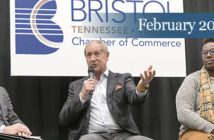Photo above: Travis Staton and Brianna Morris Fillers at the offices of the United Way of Southwest Virginia in Abingdon. Photo by Scott Robertson
By Scott Robertson
Imagine if the United Way decided to be not just a clearinghouse where employers could go to guarantee their charitable contributions would be well-directed, but to also be one of the driving forces in addressing issues like regional workforce development. Imagine what it would be like if that familiar not-for-profit brought together CEOs, legislators, administrators, workforce investment boards and school system superintendents to begin addressing workforce issues. And imagine what could happen if the business community, including the region’s largest employers, backed that United Way’s play.
It’s all very real, and happening right now in Southwest Virginia.
On Sept. 26 and 27, the United Way of Southwest Virginia will, through its Ignite program, host a Careers Expo for Youth at the Washington County Fairgrounds. More than 4,300 seventh grade student from 46 schools in 17 systems will attend. They will be introduced to regional employers in 16 different career paths, with more than 75 hands-on activities, all the while learning about the jobs and careers available within a few miles of their homes.
As that event is taking place, on the morning of Sept. 27, Travis Staton, president and CEO of the United Way of Southwest Virginia will be joined onstage at the Operation Tomorrow’s Workforce Leaders’ Breakfast by Steve Smith, the president and CEO of K-VA-T Food Stores (Food City); Alan Levine, president of Mountain States Health Alliance; and Stephen Moret, president and CEO of the Virginia Economic Development Partnership to address workforce issues. More than 200 regional business, economic development and education leaders are expected to attend.
“Over the past four to five years, we have been pulling together leadership throughout Southwest Virginia to collaborate, talk to one another and work together,” Staton says. “At this breakfast we would like to begin laying out actionable steps. We have some resources we want to bring to the table, and functions we want to share with the rest of the business community.”
Filling the gap between the worlds of learning and work involves doing some new and different things, Staton says. “It means bringing some teachers out into workplaces. It means bringing some businesspeople into the classroom. Our best teachers may not be aware of what local employers can offer as the best career options to their students. This Careers Expo is not only to expose students to careers, but also to help teachers know what’s available.”
In addition, the Ignite program will cover substitute teacher costs to allow sixth grade math and science teachers to visit regional employers. That program also connects middle and high school students with employers through career guidance and work-based learning. This year, 16 school systems in Southwest Virginia have signed on to the program, creating a total reach of around 26,000 students.
Using the software that’s part of the Ignite program, Staton says, administrators will be able to put together a clear picture of how many students want to pursue particular career paths, thus helping both educators and employers plan for the short- and long-term future.
“The Expo is just one piece of the Ignite program,” says Brianna Morris Fillers, marketing and communications manager for the United Way of Southwest Virginia. “It’s designed to help make the students and teachers better aware of the employers here and inspire them to see if they might want to pursue one of those careers here. But then they will go back to the school, take their career assessment, and make their plan with their Ignite coordinator.”
Clearly, this is not your father’s United Way.
The fact that this “community impact” model for the United Way is so remarkable that Staton and his team were invited to speak at a United Way worldwide conference earlier this year is a powerful story in and of itself. Staton, however, prefers not to look back at the changes in the organization, but rather to look forward to the positive changes communities in Southwest Virginia can realize as a result.
“We are well-positioned with our capacity and the beauty of the United Way and its localness. We have the ability to change and adapt where other organizations can’t be that nimble,” Staton says. “People don’t need us to do the things that Guidestar and Charity Navigator do today. People need more of an organization that can lead positive change, and can identify what areas need to be brought up and focused on. At the end of the day, this is still about good education, stable income and health.”




